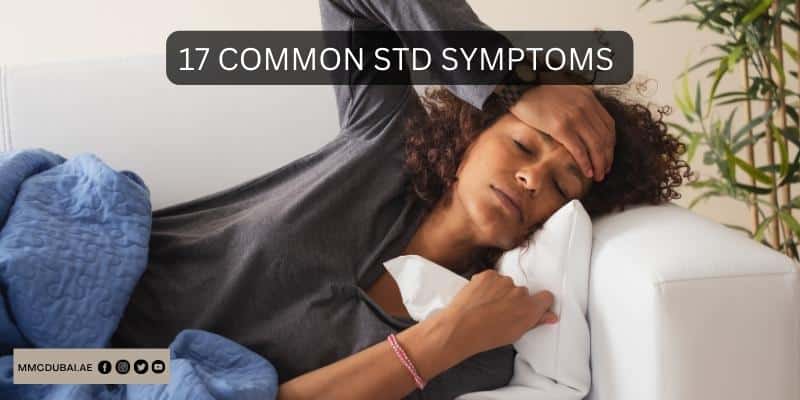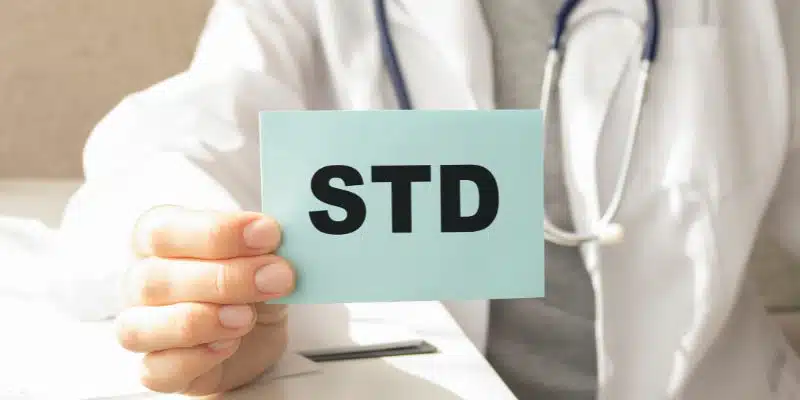
17 COMMON STD SYMPTOMS YOU SHOULD NOT IGNORE
Sexually transmitted diseases (STDs) are commonly called sexually transmitted infections (STIs). They are infections contracted through sexual contact with another person. Fortunately, most STDs are treatable. How can you tell whether you have one? What’s the best course of action? The answer to these questions will be helpful in this article. So, Stay tuned!
More than 20 distinct types of sexually transmitted infections (STIs) are currently known, according to the CDC. Additionally, the infection affects more than 20 million Americans annually. The age range of half of these individuals is between 15 and 24.
Functions That Male Reproductive Organs Perform
The following are the specialized functions of the male reproductive system:
- To produce, transport, and maintain sperm (the male reproductive cells) and semen (the protective fluid)
- To discharge sperm into the female reproductive tract
- To secrete and produce male sex hormones
The external structures of the male reproductive anatomy include:
- Testicles (testes)
- Penis
- Scrotum
The internal structures of the male reproductive anatomy include the following:
- Prostate Gland
- Bulbourethral Glands (Cowper’s Gland)
- Vas Deferens
- Ejaculatory Ducts
- Urethra
- Seminal Vesicles
Std Symptoms Of Men
There are no STD symptoms. Unfortunately, this situation is more prevalent in men. It is possible to experience a mild illness that resembles the flu but is easy to overlook.
- Pain upon urination
- Pain upon ejaculation
- A rash on the penis, groin or testicles
- Itching at the tip of the penis
- Sore throat (following oral sex)
- Fever-like Std symptoms that do not go away
- Pain, swelling, or tenderness in the testicles
- Swelling in the joints
- Pain or swelling of the urethra (the tube that connects the penis to the bladder to transport urine)
- Rectal discharge, bleeding, or pain
Functions That Female Reproductive Organs Perform
The female reproductive system serves several purposes. The ovaries produce the female egg cells, also known as ova or oocytes. The oocytes are then taken to the fallopian tube, where sperm can fertilize them. The fertilized egg next makes its way to the uterus, where the normal hormones of the reproductive cycle cause the lining to thicken.
The fertilized egg can implant into the thickened uterine lining and continue to develop once it is in the uterus. The menstrual flow causes the uterine lining to shed if fertilization fails. Additionally, female sex hormones are produced by the female reproductive system to maintain the reproductive cycle.
The female reproductive system gradually stops producing the hormones that are necessary for the reproductive cycle to function during menopause. Menstrual cycles can become more irregular and eventually stop at this point. A woman is deemed to be in menopause after one year following the cessation of her menstrual cycles.
There are both external and internal structures in the female reproductive anatomy.
The genitals, or external female reproductive structures, serve two purposes:
- To make it possible for sperm to enter the body
- To keep infectious organisms out of the internal genital organs
The female reproductive system’s main external structures are:
- Bartholin Glands
- Clitoris
- Labia Minora
- Labia Majora
The internal structures of the female reproductive anatomy include the following:
- Ovaries
- Fallopian Tubes
- The uterus (womb)
Std Symptoms Of Women
- Vaginal discharge can be thick or thin, and it can be of any consistency or color (white, yellow, or greenish)
- Itching of the vulva or vagina
- Blisters on the vulva (the external genitals)
- Rash on the vulva/vagina
- Burning sensation during urination
- Painful intercourse
- Sore throat (after oral sex)
- Pelvic pain
- Bleeding or spotting between menstrual cycles
- Lower back pain
- Fever Rectal pain, bleeding, or discharge (after anal sex)
No Std Symptoms
You could be infectious even if you don’t show any apparent Std symptoms, and your infection could spread and cause serious harm. This harm may result in damage that cannot be resolved, such as infertility for life.
If you had oral, butt-centric or vaginal intercourse and genital contact, you can get a sexually transmitted disease called a sexually transmitted infection (STI). You are susceptible to STIs and their Std symptoms regardless of your sexual orientation or marital status. It is not enough to believe or hope your partner does not have an STI. You must know for sure!
When used correctly, condoms significantly reduce the transmission of some STDs. However, no method is 100% effective, and STI symptoms may not always be apparent. See a doctor If you suspect an STI or have been exposed to one. Also, let your partner or partners know so they can be assessed and treated.
How quickly do Std symptoms appear?
The specific pathogen and the individual both play a role in the length of time between infection and the onset of std symptoms if they occur at all. Std symptoms frequently go unnoticed or do not show up at all. An STD should never be ignored, despite this. Many sexually transmitted diseases (STDs) have the potential to progress and result in damage that cannot be undone.
Keep in mind that regardless of symptoms, an infected person can still spread the disease to others. Std symptoms of a sexually transmitted disease may manifest within four to five days or four to five weeks, depending on the specific pathogen (disease-causing organism). Some infections may present with observable signs and Std symptoms even months after the initial infection.
Some STIs are simple to treat; Others need treatment that is more involved to manage. STIs can make you more likely to get other STIs, like HIV, if you don’t get treatment. This happens on the grounds that an STI can invigorate a safe reaction in the genital region or cause wounds, both of which could raise the gamble of HIV transmission. Infertility, organ damage, certain types of cancer, and even death are all possible outcomes of some untreated STIs.
Asymptomatic STI
STIs that don’t show any signs or Std symptoms are called asymptomatic. However, the infection can spread to your sexual partners even if you don’t show any Std symptoms. As a result, it’s critical to use protection during sex, like a condom. Additionally, it would be best if you went to your doctor regularly for an STI screening to treat an infection before it spreads to others.
Symptoms of Chlamydia
Chlamydia is a genital tract bacterial infection. Early-stage infections of chlamydia typically don’t cause any signs or Std symptoms, making it difficult to diagnose the disease. When they do, they usually have a mild effect and go away quickly one to three weeks after exposure to chlamydia.
Examples of Std symptoms include:
- Lower abdominal pain
- Painful urination
- Discharge from the vagina in women
- Discharge from the penis in men
- Testicular pain in men
- Pain during sexual activity
- Bleeding between periods in women
Symptoms Of Gonorrhea
Gonorrhea is a genital tract infection caused by bacteria. The bacteria can also spread to your eyes, nose, throat, and mouth. In most cases, gonorrhea symptoms begin ten days following exposure. However, some people may not exhibit Std symptoms for months after contracting the infection.
Signs and side effects of gonorrhea might include:
- Heavy menstrual bleeding or bleeding between periods;
- painful, swollen testicles
- anal itching
- thick, bloody or cloudy discharge from the penis or vagina
- painful bowel movements
Symptoms of Trichomoniasis
Trichomoniasis is a common STI brought on by the one-celled, microscopic parasite Trichomonas vaginalis. Sexual contact with a person who already has the infection spreads this organism.
Typically, the organism infects men’s urinary tract without causing Std symptoms. Women typically contract trichomoniasis through their vagina. The signs and Std symptoms of trichomoniasis can last anywhere from five to 28 days and range from mild irritation to severe inflammation.
Examples of Std symptoms include:
- Vaginal discharge that is clear, white, greenish, or yellowish
- Vaginal discharge with a strong odor
- Vaginal itching or irritation
- Itching or irritation inside the penis
- Pain while having sex Painful urination
Early Signs And Side Effects
Early HIV signs and side effects typically vanish in the span of seven days to a month and are frequently confused with those of another viral disease. You are highly contagious during this time.HIV infection may not manifest more severe or persistent Std symptoms until 10 years or more after the initial infection. Some early HIV Std symptoms include:
- Swollen lymph nodes
- Headache
- Fever
- sore throat
- Rashes
- Fatigue
You may develop mild infections or persistent signs, and Std symptoms like the following as the virus continues to multiply and destroy immune cells showing Std symptoms:
- Among the earliest indicators of HIV infection is swelling of the lymph nodes
- Diarrhea
- Weight loss
- Fever, cough
- Shortness of breath
- Late-stage HIV infection
The following signs and Std symptoms can indicate late-stage HIV infection:
- Uncommon, opportunistic infections
- Chronic diarrhea
- Shaking chills or a higher fever than 100.4 F (38 C) last for weeks
- Persistent headaches
- Uncommon, opportunistic fatigue
- Soaking night sweats
- lymph node swelling that lasts longer than three months
Symptoms Of Genital Herpes
A strain of the herpes simplex virus (HSV) that enters the body through minute cracks in the skin or mucous membranes causes the highly contagious STI known as genital herpes. The majority of people who have HSV don’t show any Std symptoms at all, or their symptoms are so mild that they go unnoticed.
The first episode typically presents the most severe signs and symptoms. Some individuals never see another episode. However, others may experience decades of recurrent seizures.
Std symptoms of genital herpes can include the following when it is present:
- Ulcers can make urination painful
- Small red bumps, vesicles, or open sores in the genital and anal regions and surrounding regions
- While the infection is still present, you might also experience tenderness and pain in your genital area
- Itching or discomfort in the inner thighs, buttocks, or genital region
- Swollen lymph nodes in your groin and flu-like symptoms and signs, such as muscle aches, headache and fever, may appear during the initial episode
- Even if no sores are present, the infection may still be active and contagious in some instances
The Std symptoms of genital warts and human papillomavirus (HPV) infection
One of the most prevalent STIs is an infection with the HPV virus. Women who have certain types of HPV are more likely to develop cervical cancer. Genital warts are caused by other forms. In most cases, HPV does not cause Std symptoms. Among the symptoms of genital warts are:
- Small, gray or flesh-colored bumps in your genital area
- Itching or discomfort in your genital area
- Multiple warts in close proximity that resemble cauliflower
- Bleeding during sexual activity
- Occasionally, however, genital warts do not cause symptoms
- Warts on the genital area can be as small as one millimeter in diameter or grow in large clusters. Warts can also form in the throat or mouth of people who have had oral sex with infected people
Symptoms Of Hepatitis
You can contact any of the hepatitis A, B, and C. These are three contagious viral infections that affect your liver. The most serious of the three are hepatitis B and C, both of which can cause inflammation in the liver.
Some people never show any symptoms. However, for those who do, the following signs and symptoms may appear several weeks after exposure:
- Abdominal pain or discomfort, particularly in the liver area on your right side beneath your lower ribs
- Fatigue
- Nausea
- Vomiting
- Appetite loss
- Fever,
- Dark urine
Symptoms Syphilis
Syphilis is an infection caused by bacteria. The disease affects your skin, mucous membranes, and genitals, but it can also affect your brain and heart, as well as many other parts of your body.
There are three possible stages of syphilis: primary, secondary, and tertiary. Latent syphilis is another condition in which there are no symptoms but blood tests show that the bacteria are present.
At first, the site of infection, typically the genitals, rectum, tongue, or lips, may only have a small, painless sore (chancre). Std symptoms of the disease may include:
- Red or reddish-brown
- penny-sized rashes on any part of your body, including your palms and soles,
- Fatigue, and a vague sense of discomfort
- Fever
- Enlarged lymph nodes
The bacteria that cause syphilis may spread without treatment, causing severe damage to internal organs and death years after the initial infection.
Here are some signs and Std symptoms of late-stage syphilis:
- Numbness
- Lack of coordination
- Paralysis
- Blindness
- Dementia
Congenital syphilis, which happens when a pregnant woman with the disease transmits it to her unborn child, is characterized by all of these signs and Std symptoms. Congenital syphilis can be crippling or even fatal, and treating pregnant women who have the disease is critical.
Neurosyphilis Syphilis
Neurosyphilis Syphilis can affect the nervous system at any stage. Neurosyphilis can cause either no Std symptoms at all or:
- Headaches
- Change in behavior
- Problem in movement
Consult your doctor if you believe you have been exposed to one of these or other STIs or if you think you might have them yourself. To avoid or delay more severe, potentially life-threatening health issues and to avoid infecting others, prompt diagnosis and treatment are essential.
Tips for preventing STIs
- The only 100% effective way to prevent STIs is not to have any sexual relationships. However, there are ways for trusted sources to lessen the gamble of both getting an STI and creating intricacies:
- Correctly using condoms and other barrier methods lowers the likelihood of touching bodily fluids.
- Encourage your partners to undergo regular testing as well. It is essential to request specific testing in order to obtain your results due to the fact that STI screening is not included in a typical health examination.
- Discuss your sexual history and test results with your partners openly.
- Take into consideration getting HPV and hepatitis B vaccines.
- Pre-exposure prophylaxis (PrEP) is a preventive treatment that should be discussed with a healthcare professional if you have a higher risk of contracting HIV.
- The majority of STIs can be treated if not eliminated. The most important things are infection prevention whenever possible and routine screening to ensure that any infections are treated promptly.
Conclusion
It is essential to seek medical advice from a qualified healthcare professional whenever you experience any Std symptoms, regardless of how insignificant they may be. In this article, you have learned about potential and common STD symptoms and their potential severity.
For queries, drop a comment, and for STD Testing Dubai appointments, contact us! For further information on STD Testing Dubai, click the link below!
FAQs (Frequently Asked Questions)
Below are the most frequent questions people ask about STD symptoms for std testing Dubai.
How does an STD feel?
However, itching, a burning sensation when you urinate, and unusual and unpleasant discharge are all STD symptoms. If any of these indications exist, you should see a doctor right away.
How can I confirm if I have an STD female?
Laboratory tests can demonstrate the presence of any bacterial or viral STIs. A blood test can tell you if you suffer from a blood-borne illness. If you have an STI, urine samples can show if you have bacteria in your urine. Fluid samples can help determine the type of infection and reveal if you have active sores.
When an STD goes away, how long does it take?
The medicine takes seven days to work in your body and eliminate the Chlamydia infection. Even if you don’t show any Std symptoms, if you have sex without a condom after taking the medication for seven days, you could still spread the infection to your partners.
What is a best antibiotic for STDs?
The following are some of the prescribed antibiotics for various bacterial STDs:
1. Chlamydia treatment with erythromycin, doxycycline, and azithromycin
2. Gonorrhea treatment with ceftriaxone, cefixime, ciprofloxacin, and ofloxacin
3. Gonorrhea and chlamydia can be treated with ceftriaxone and doxycycline or azithromycin
Syphilis-specific penicillin G
Who is most susceptible to STDs?
The majority of these infections affect individuals aged 15 to 24. There are several reasons why young people are more likely to get STDs. The bodies of young women are biologically more susceptible to STDs.



